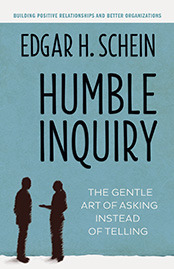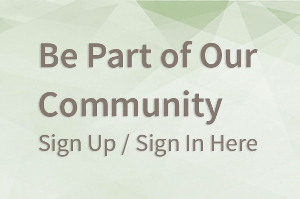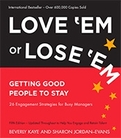BK Blog Post
Don't Let Rank and Status Get In the Way of Teamwork
 Posted by
Charlotte Ashlock,
Executive Editor,
Berrett-Koehler Publishers Inc.
Posted by
Charlotte Ashlock,
Executive Editor,
Berrett-Koehler Publishers Inc.
Charlotte Ashlock is a crazy idealist trying to make the world a better place!
Edgar Schein's book Humble Inquiry outlines a way of asking questions that strengthens teamwork and improves results. In this excerpt from his book, he explains how you can navigate around rank and status issues which prevent clear communication by using the tool of "humble inquiry."
***
In order to understand some of the inhibitors of Humble Inquiry, we have to examine particularly the rules pertaining to behavior between people of different status or rank. From the subordinates’ points of view, these rules can best be thought of as the rules of deference, or how subordinates are supposed to show respect for their superiors; from the superiors’ points of view, they are the rules of demeanor, or how superiors are supposed to act in a way that is appropriate to their status. For example, when the superior is speaking, the subordinate is supposed to pay attention and not interrupt; the superior is supposed to make sense and behave in a dignified manner.
We take these rules so for granted that we only notice them when they are situationally inappropriate, as when a subordinate speaks out of turn or a leader says or does something that is insulting or stupid. We have very clear expectations about what is the appropriate demeanor for a high-status person, and it arouses anxiety and anger when those expectations are not met. It is not accidental that higher-status people are given private bathrooms so that they can properly compose themselves before appearing in public.
Similarly, we have clear rules about deference, which vary depending on the culture. A dramatic case of misunderstanding such rules occurred years ago in the South African gold mines when white supervisors consistently viewed tribal workers as being untrustworthy because they were “shifty eyed” and “never looked you in the eye.” It took years of supervisory training to teach the white managers that in the tribal culture looking a superior in the eye was a mark of disrespect and would be punished.
When we enter a new situation or meet someone and start a conversation, one of the first things that we sort out unconsciously is the relative status distinctions that must be observed. Some might argue we are still biologically programmed to locate ourselves in the pecking order. We often start with Humble Inquiry in such a situation because it provides an opportunity to find out whether the other person in the conversation is of higher or lower status, whether we should be deferent or alternatively should expect deference. We start by asking general questions—what kind of work do you do? Where do you live? What brings you here? If the cues are that the other person is of lower status, as when some undergraduates approached me at a recent meeting and asked to have their picture taken with me because they had read and liked some of my work, I automatically assumed the appropriate demeanor of being flattered and posed urbanely with a big smile. On the other hand, this same kind of instant adjustment was illustrated when I was recently introduced to a fellow resident of my retirement complex and learned that he was a Nobel Prize–winning physicist. I found myself feeling humble and asking very open-ended questions to learn more about him. Since we were of similar age and both residents in the same retirement community, he also took a more humble position well into the conversation, which reduced the status gap and led to a more informal open exchange.
...
Situational rules determine the appropriate form of Humble Inquiry where there is a status or rank difference at the outset of the conversation. What we have to learn as we look ahead to more interdependent tasks is how to bridge those status gaps when we are in fact mutually dependent on each other. It will be easy for the subordinate to continue to be humble and ask for the help of the superior. The dilemma that will require new learning is how the superior can learn to ask for help from the subordinate. To begin to understand how to deal with that dilemma, we have to look also at different types of role relations.
Personalization is the process of acknowledging the other person as a whole human, not just a role. The minimal level of personalization in this sense would be to share first and last names. So when Dr. Brown is first introduced to his operating room nurse as Ms. Grant and his anesthetist as Dr. Tanaka, this would be an example of formal role introductions. In a formal traditional hospital setting, that is what would be done, and that would be the end of it. If the hospital head wanted to personalize the relationship somewhat, the initial introduction by the chief of surgery might be “Dr. Brown, this will be your nurse, Amy Grant, and your anesthetist, Dr. Yoshi Tanaka.” Such minimal personalization might have powerful effects if it is a change from past practice. And it may possibly bend the rules a bit as well, if the hospital tradition has been one of maintaining professional decorum. I know of one hospital that decided on first names among the medical staff but never in front of patients because the patient had to be reminded of the relative statuses of the medical team members. Would the patient lose respect for Dr. Brown if Amy called him “Rod?”
Once the process of personalization has been launched and accepted, in that both parties display comfort with first names, the Pandora’s box is opened to endless other personal questions and revelations. But this process is not without its own situational propriety that we all live by. Staying on the role/task level, Dr. Brown might ask Amy where she got her training, what other doctors she had worked with, whether she was headed for a particular specialty, and so on. If he wanted to become more personal, he might ask some questions about where she lives, whether she has a family, where she is from, and what she thinks of the hospital in which they both work. The question about her view of the hospital might be pushing the boundary in that she might not know how safe it would be to tell Dr. Brown exactly what she thought and felt, especially if she had some criticisms.
How personalization might proceed from this point on might depend very much on when and where this conversation was being held. Amy Edmondson, in her study of cardiac surgical teams doing open-heart surgery, reported that some of these teams functioned better in doing this very complicated surgery than others. At a recent meeting, she mentioned a detail that is central to this analysis. Edmondson was in the cafeteria where all the staff tended to sit by rank and occupation, and she noticed that one of these successful teams was sitting at a table with each other. Evidently they had decided that spending time with each other was more important than for each of them to eat with their professional peers. This decision enabled them to explore getting to know each other at a more personal level, something that they evidently felt they needed to do in order to function well as a team in the OR. Edmondson’s study showed that the teams that were able to adopt and successfully utilize the more complex surgical process had made a special effort to learn together as a team and, thereby, reduce status differences and make everyone aware of their mutual interdependence. Eating together was just one of many activities that personalized their relationships.
The point is that a small change—whom one eats lunch with—has huge symbolic implications for relationship building in that the senior doctor is publicly humbling himself by sitting with his subordinate staff, thereby empowering them to be more open with him.
In another example, one of Edmondson’s doctoral students, Melissa Valentine, studied hospital emergency rooms that were overloaded and needed to find a solution to the long times that patients spent in the emergency unit. One hospital decided to create small “pods” consisting of one of every kind of intake professional needed to treat emergency cases. Patients and staff would be arbitrarily assigned to pods based on where there was a vacancy at that moment. What this meant was that, over a period of time, each doctor, nurse, and technician would meet many other doctors, nurses, and technicians but always in a small-group context that facilitated personalization. Instead of a nurse having to find a doctor when a patient was ready to be seen, there was always a doctor available in the pod. The smaller size of the pod created more opportunities for face-to-face interaction, which made Humble Inquiry and personalization easier.
Humble Inquiry is by definition more personal because it hinges on being curious about and interested in the other person, but the choice of topic can range from task related to very intimate. That choice also has to take into account various cultural factors because what is considered personal is itself determined by rules that derive from organizational histories, the cultures of occupations, and national cultures.
***
Want to learn more about how to bridge the status gap? Check out Humble Inquiry for more.






